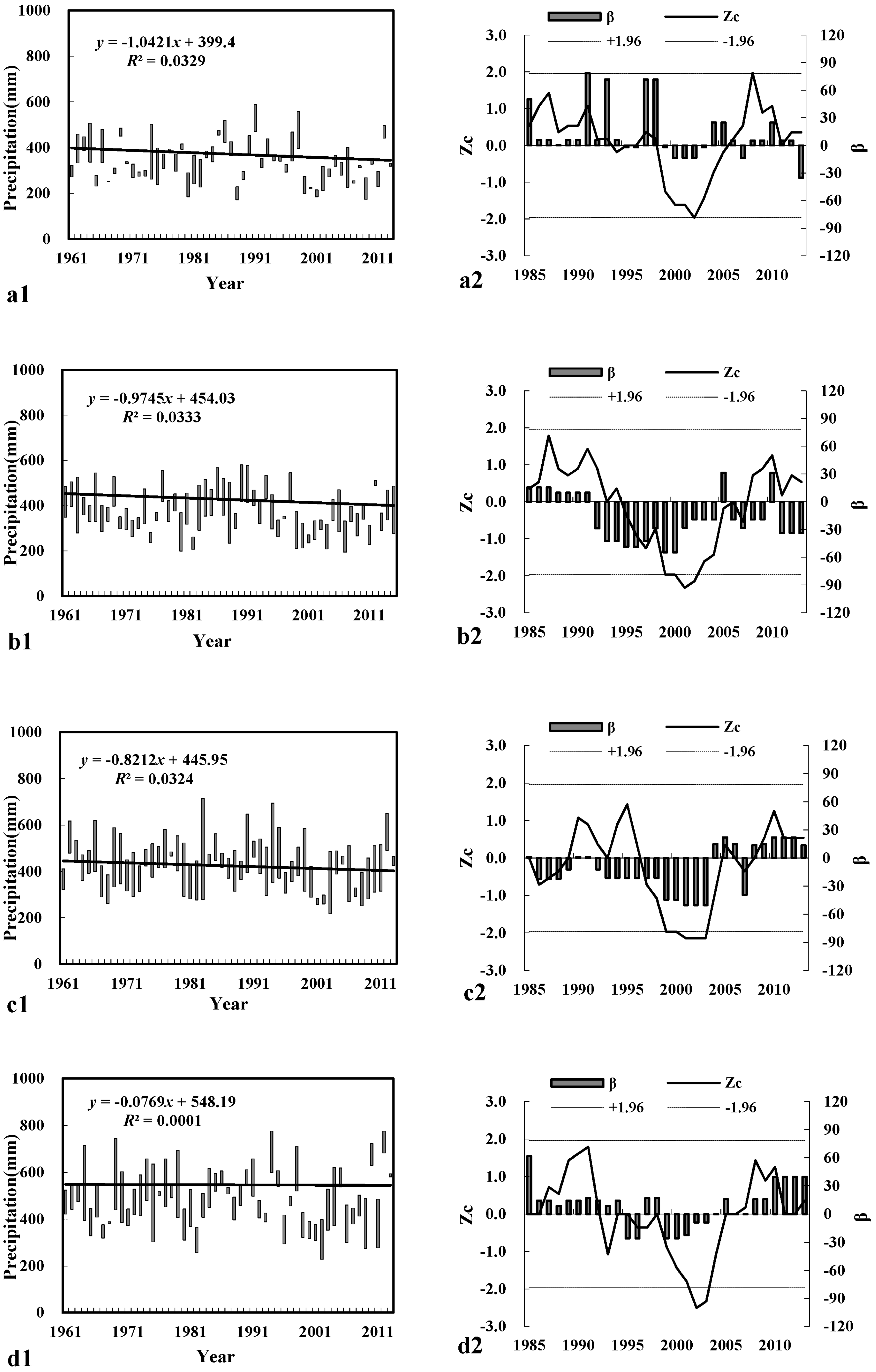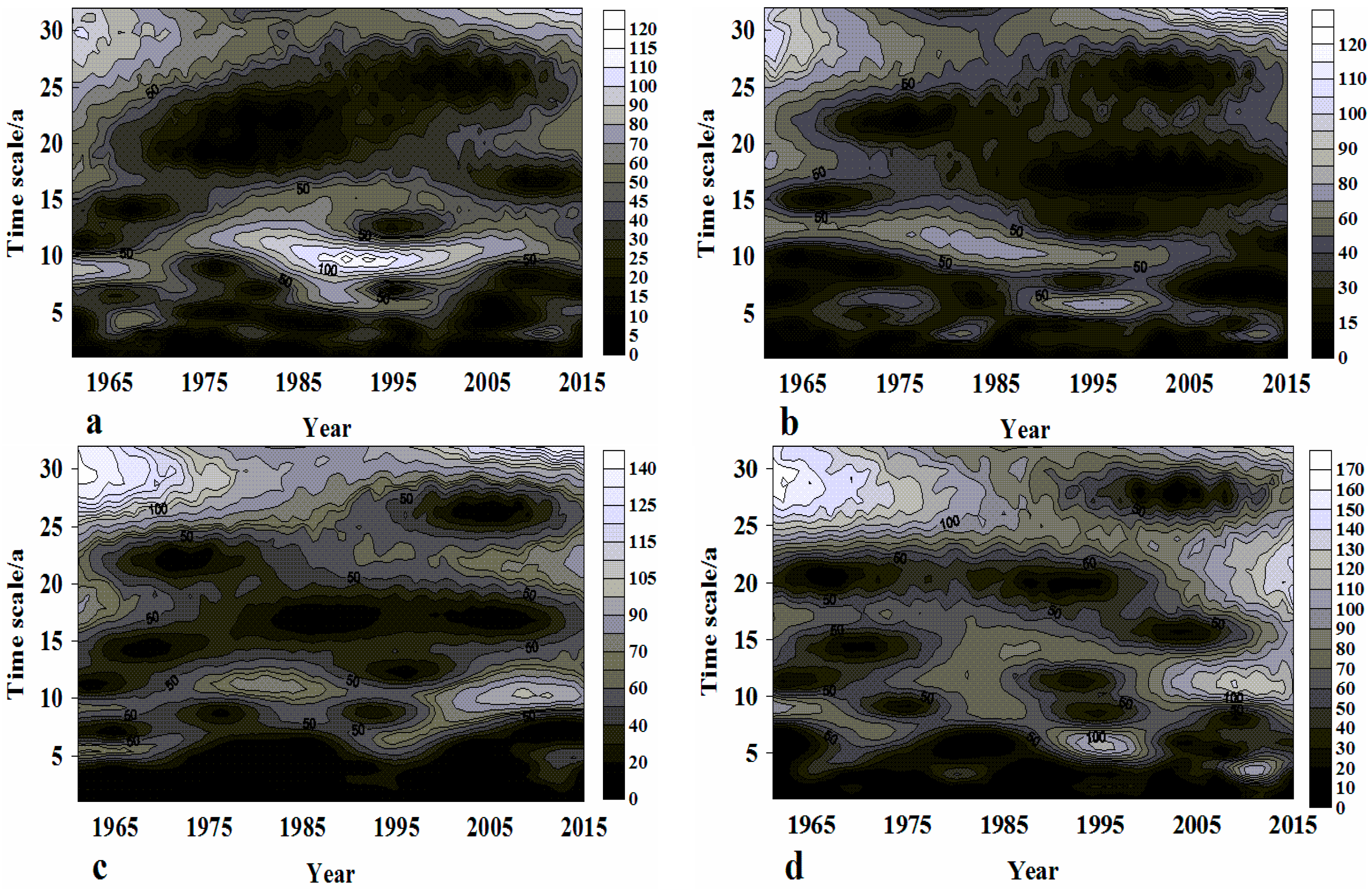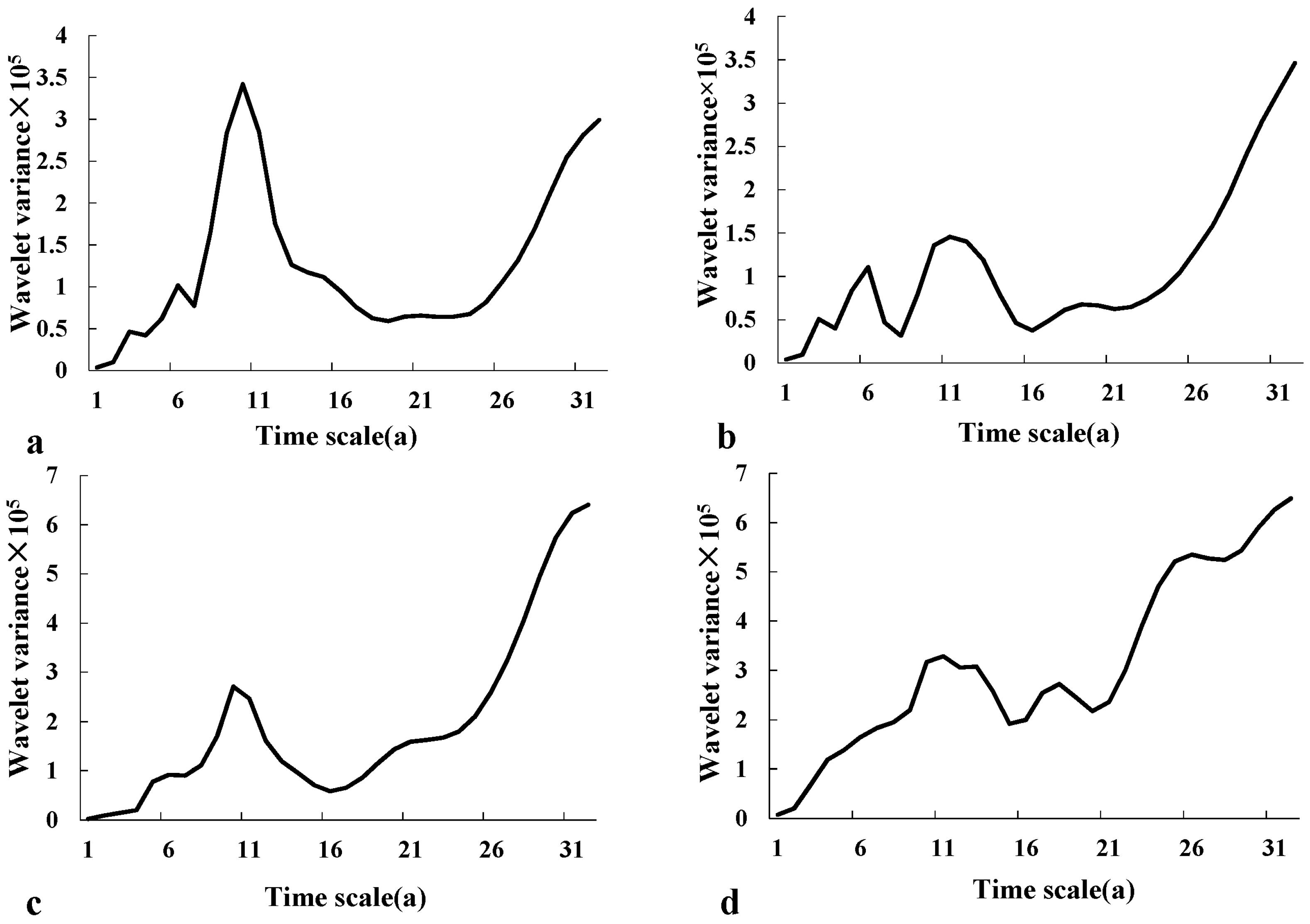Annual Precipitation Fluctuation and Spatial Differentiation Characteristics of the Horqin Region
Abstract
:1. Introduction
2. Study Area and Method
2.1. Overview of the Study Area
2.2. Selection of Meteorological Stations for Rainfall Distribution
2.3. The Wavelet Analysis Method
2.4. The Mann–Kendall (M-K) Rank Correlation Method
3. Results
3.1. The Characteristic of Precipitation Fluctuation Year by Year
3.2. The Interdecadal Change of Precipitation Fluctuation
3.3. The Inter-Annual Fluctuation of Precipitation
3.3.1. Analysis of the Isoline of Wavelet Coefficient Real Part of Precipitation Sequence Change
3.3.2. Analysis of the Isoline of Wavelet Module Change of Precipitation Sequence
3.3.3. Wavelet Variance Analysis of the Precipitation Sequence
4. Discussion
5. Conclusions
Acknowledgments
Author Contributions
Conflicts of Interest
References
- Gao, Q.; Reynolds, J.F. Historical shrub-grass transitions in the northern Chihuahuan Desert: Modeling the effects of shifting rainfall seasonality and event size over a landscape gradient. Glob. Chang. Biol. 2003, 9, 1475–1493. [Google Scholar] [CrossRef]
- Noy-Meir, I. Desert ecosystems: Environment and producers. Annu. Rev. Ecol. Evol. Syst. 1973, 4, 25–51. [Google Scholar] [CrossRef]
- Sala, O.; Lauenroth, W. Small rainfall events: An ecological role in semiarid regions. Oecologia 1982, 53, 301–304. [Google Scholar] [CrossRef]
- Reynolds, J.F.; Kemp, P.R.; Ogle, K.; Fernández, R.J. Modifying the ‘pulse-reserve’ paradigm for deserts of North America: Precipitation pulses, soil water, and plant responses. Oecologia 2004, 141, 194–210. [Google Scholar] [CrossRef] [PubMed]
- Reichmann, L.G.; Sala, O.E.; Peters, D.P. Precipitation legacies in desert grassland primary production occur through previous-year tiller density. Ecology 2013, 94, 435–443. [Google Scholar] [CrossRef] [PubMed]
- Jankju-Borzelabad, M.; Griffiths, H. Competition for pulsed resources: An experimental study of establishment and coexistence for an arid-land grass. Oecologia 2006, 148, 555–563. [Google Scholar] [CrossRef] [PubMed]
- Shihai, L.; Liu, J.; Zheng, Z.; Shengxing, Y.E.; Chang, X. Effects of the Annual Precipitation Fluctuation on Primary Productivity in Hulunbeier Meadow-Steppe. Res. Environ. Sci. 2015, 28, 550–580. [Google Scholar]
- Chesson, P.; Gebauer, R.L.; Schwinning, S.; Huntly, N.; Wiegand, K.; Ernest, M.S.; Sher, A.; Novoplansky, A.; Weltzin, J.F. Resource pulses, species interactions, and diversity maintenance in arid and semi-arid environments. Oecologia 2004, 141, 236–253. [Google Scholar] [CrossRef] [PubMed]
- Knapp, A.K.; Fay, P.A.; Blair, J.M.; Collins, S.L.; Smith, M.D.; Carlisle, J.D.; Harper, C.W.; Danner, B.T.; Lett, M.S.; McCarron, J.K. Rainfall variability, carbon cycling, and plant species diversity in a mesic grassland. Science 2002, 298, 2202–2205. [Google Scholar] [CrossRef] [PubMed]
- Lu, L.; Li, X.; Cheng, G. Landscape evolution in the middle Heihe River Basin of north-west China during the last decade. J. Arid Environ. 2003, 53, 395–408. [Google Scholar] [CrossRef]
- Schwinning, S.; Starr, B.I.; Ehleringer, J.R. Dominant cold desert plants do not partition warm season precipitation by event size. Oecologia 2003, 136, 252–260. [Google Scholar] [CrossRef] [PubMed]
- Ryel, R.J.; Leffler, A.; Peek, M.; Ivans, C.; Caldwell, M. Water conservation in Artemisia tridentata through redistribution of precipitation. Oecologia 2004, 141, 335–345. [Google Scholar] [CrossRef] [PubMed]
- Hamerlynck, E.P.; Scott, R.L.; Stone, J.J. Soil moisture and ecosystem function responses of desert grassland varying in vegetative cover to a saturating precipitation pulse. Ecohydrology 2012, 5, 297–305. [Google Scholar] [CrossRef]
- Smith, S.D.; Monson, R.K.; Anderson, J.E. Physiological Ecology of North American Desert Plants; Springer: Berlin, Germany, 2012. [Google Scholar]
- Loik, M.E.; Breshears, D.D.; Lauenroth, W.K.; Belnap, J. A multi-scale perspective of water pulses in dryland ecosystems: Climatology and ecohydrology of the western USA. Oecologia 2004, 141, 269–281. [Google Scholar] [CrossRef] [PubMed]
- Ehleringer, J.R.; Phillips, S.L.; Schuster, W.S.; Sandquist, D.R. Differential utilization of summer rains by desert plants. Oecologia 1991, 88, 430–434. [Google Scholar] [CrossRef]
- Snyder, K.; Tartowski, S. Multi-scale temporal variation in water availability: Implications for vegetation dynamics in arid and semi-arid ecosystems. J. Arid Environ. 2006, 65, 219–234. [Google Scholar] [CrossRef]
- Xu, Z.; Li, J.; Liu, C. Long-term trend analysis for major climate variables in the Yellow River basin. Hydrol. Process. 2007, 21, 1935–1948. [Google Scholar] [CrossRef]
- Yang, Y.; Tian, F. Abrupt change of runoff and its major driving factors in Haihe River Catchment, China. J. Hyrol. 2009, 374, 373–383. [Google Scholar] [CrossRef]
- Hamed, K.H.; Rao, A.R. A modified Mann-Kendall trend test for autocorrelated data. J. Hyrol. 1998, 204, 182–196. [Google Scholar] [CrossRef]
- Mondal, A.; Kundu, S.; Mukhopadhyay, A. Rainfall trend analysis by Mann-Kendall test: A case study of north-eastern part of Cuttack district, Orissa. Int. J. Geol. Earth Environ. Sci. 2012, 2, 70–78. [Google Scholar]
- Yan-Sheng, Y.U.; Chen, X.W. Study on the Percentage of Trend Component in a Hydrological Time Series Based on Mann-Kendall Method. J. Nat. Resour. 2011, 26, 1585–1591. [Google Scholar]
- Rodriguez-Iturbe, I. Ecohydrology: A hydrologic perspective of climate-soil-vegetation dynamies. Water Resour. Res. 2000, 36, 3–9. [Google Scholar] [CrossRef]
- Yao, S.; Zhang, T.; Zhao, C. Multiple-time-scale Analysis on Precipitation in Naiman Banner of Horqin Sandy Land in 1970–2010. J. Desert Res. 2014, 34, 542–549. [Google Scholar]
- Li, M.; Xia, J.; Meng, D. Long-Term Trend Analysis of Seasonal Precipitation for Beijing, China. J. Nat. Resour. 2012, 3, 64–72. [Google Scholar]
- Liu, X.; He, Y.; Zhao, X.; Zhang, T.; Li, Y.; Yun, J.; Wei, S.; Yue, X. The response of soil water and deep percolation under Caragana microphylla to rainfall in the Horqin Sand Land, northern China. Catena 2016, 139, 82–91. [Google Scholar] [CrossRef]
- Kumar, P.; Foufoula-Georgiou, E. Wavelet analysis for geophysical applications. Rev. Geophys. 1997, 35, 385–412. [Google Scholar] [CrossRef]
- Kantelhardt, J.W.; Rybski, D.; Zschiegner, S.A.; Braun, P.; Koscielny-Bunde, E.; Livina, V.; Havlin, S.; Bunde, A. Multifractality of river runoff and precipitation: Comparison of fluctuation analysis and wavelet methods. Physica A 2003, 330, 240–245. [Google Scholar] [CrossRef]
- Labat, D.; Ababou, R.; Mangin, A. Rainfall-runoff relations for karstic springs. Part II: Continuous wavelet and discrete orthogonal multiresolution analyses. J. Hyrol. 2000, 238, 149–178. [Google Scholar] [CrossRef]
- Hamed, K.H. Exact distribution of the Mann-Kendall trend test statistic for persistent data. J. Hyrol. 2009, 365, 86–94. [Google Scholar] [CrossRef]
- Liu, X.P.; He, Y.H.; Zhao, X.Y.; Zhang, T.H.; Li, Y.L.; Yun, J.Y. Characteristics of Precipitation in Naiman Region of Horqin Sandy Land. Aust. J. Soil Res. 2011, 18, 155–158. [Google Scholar]
- Hao, Q.Z. Onset of Asian desertification by 22 Myr ago inferred from loess deposits in China. Nature 2002, 416, 159–163. [Google Scholar]
- Ramstein, G.; Fluteau, F.; Besse, J.; Joussaume, S. Effect of orogeny, plate motion and land–sea distribution on Eurasian climate change over the past 30 million years. Nature 1997, 386, 788–795. [Google Scholar] [CrossRef]
- Qian, C.; Zhou, T. Multidecadal Variability of North China Aridity and Its Relationship to PDO during 1900–2010. J. Clim. 2014, 27, 1210–1222. [Google Scholar] [CrossRef]
- Nourani, V.; Alami, M.T.; Aminfar, M.H. A combined neural-wavelet model for prediction of Ligvanchai watershed precipitation. Eng. Appl. Artif. Intell. 2009, 22, 466–472. [Google Scholar] [CrossRef]
- Partal, T.; CiGiZoglu, H.K. Prediction of daily precipitation using wavelet-neural networks. Hydrol. Sci. J. 2009, 54, 234–246. [Google Scholar] [CrossRef]
- Gholami, V.; Chau, K.W.; Fadaee, F.; Torkaman, J.; Ghaffari, A. Modeling of groundwater level fluctuations using dendrochronology in alluvial aquifers. J. Hydrol. 2015, 529, 1060–1069. [Google Scholar] [CrossRef]
- Taormina, R.; Chau, K.W. Data-driven input variable selection for rainfall-runoff modeling using binary-coded particle swarm optimization and Extreme Learning Machines. J. Hydrol. 2015, 529, 1617–1632. [Google Scholar] [CrossRef]
- Wu, C.L.; Chau, K.W.; Li, Y.S. Methods to improve neural network performance in daily flows prediction. J. Hydrol. 2009, 372, 80–93. [Google Scholar] [CrossRef]
- Wang, W.; Chau, K.; Xu, D.; Chen, X. Improving forecasting accuracy of annual runoff time series using ARIMA based on EEMD decomposition. Water Resour. Manag. 2015, 29, 2655–2675. [Google Scholar] [CrossRef]
- Chen, X.Y.; Chau, K.W.; Busari, A.O. A comparative study of population-based optimization algorithms for downstream river flow forecasting by a hybrid neural network model. Eng. Appl. Artif. Intell. 2015, 46, 258–268. [Google Scholar] [CrossRef]
- Chau, K.W.; Wu, C.L. A hybrid model coupled with singular spectrum analysis for daily rainfall prediction. J. Hydroinform. 2010, 12, 458–473. [Google Scholar] [CrossRef]






| Items | District I (mm) | District II (mm) | District III (mm) | District IV (mm) | ||||
|---|---|---|---|---|---|---|---|---|
| Average | Anomaly | Average | Anomaly | Average | Anomaly | Average | Anomaly | |
| 1960s | 357.2 | 19 | 401.5 | 33.7 | 439.3 | 16.5 | 475.5 | −11.4 |
| 1970s | 337.6 | −0.6 | 355.2 | −12.6 | 441.0 | 18.2 | 515.2 | 28.3 |
| 1980s | 338.3 | 0.1 | 373.0 | 5.2 | 416.2 | −6.6 | 478.2 | −8.7 |
| 1990s | 381.9 | 43.7 | 409.2 | 41.4 | 458.7 | 35.9 | 508.0 | 21.1 |
| 2000s | 273.2 | −65 | 301.2 | −66.6 | 349.4 | −73.4 | 417.9 | −69 |
| 2010s 1 | 341.2 | 11.6 | 385 | 6 | 437.4 | 28 | 518.8 | 97 |
| 1960–2015 | 337.4 | 0 | 369.2 | 0 | 422.6 | 0 | 483.4 | 0 |
© 2017 by the authors; licensee MDPI, Basel, Switzerland. This article is an open access article distributed under the terms and conditions of the Creative Commons Attribution (CC-BY) license (http://creativecommons.org/licenses/by/4.0/).
Share and Cite
Liu, L.; Zhao, X.; Meng, Q.; Zhao, H.; Lu, X.; Gao, J.; Chang, X. Annual Precipitation Fluctuation and Spatial Differentiation Characteristics of the Horqin Region. Sustainability 2017, 9, 111. https://doi.org/10.3390/su9010111
Liu L, Zhao X, Meng Q, Zhao H, Lu X, Gao J, Chang X. Annual Precipitation Fluctuation and Spatial Differentiation Characteristics of the Horqin Region. Sustainability. 2017; 9(1):111. https://doi.org/10.3390/su9010111
Chicago/Turabian StyleLiu, Liangxu, Xueyong Zhao, Qinglan Meng, He Zhao, Xiaoqian Lu, Junkai Gao, and Xueli Chang. 2017. "Annual Precipitation Fluctuation and Spatial Differentiation Characteristics of the Horqin Region" Sustainability 9, no. 1: 111. https://doi.org/10.3390/su9010111





